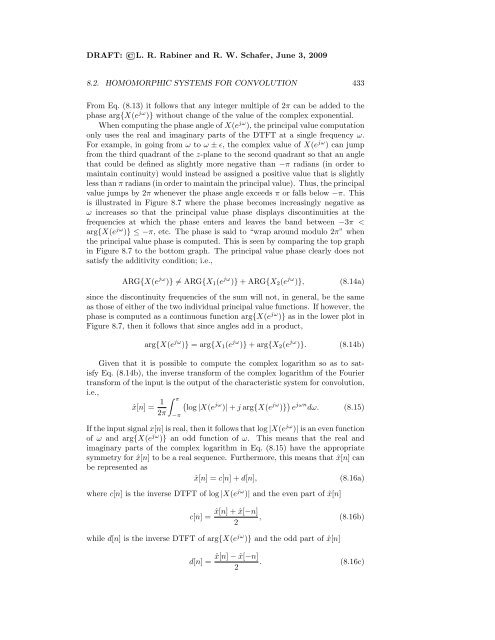LR Rabiner and RW Schafer, June 3
LR Rabiner and RW Schafer, June 3
LR Rabiner and RW Schafer, June 3
You also want an ePaper? Increase the reach of your titles
YUMPU automatically turns print PDFs into web optimized ePapers that Google loves.
DRAFT: L. R. <strong>Rabiner</strong> <strong>and</strong> R. W. <strong>Schafer</strong>, <strong>June</strong> 3, 2009<br />
8.2. HOMOMORPHIC SYSTEMS FOR CONVOLUTION 433<br />
From Eq. (8.13) it follows that any integer multiple of 2π can be added to the<br />
phase arg{X(e jω )} without change of the value of the complex exponential.<br />
When computing the phase angle of X(e jω ), the principal value computation<br />
only uses the real <strong>and</strong> imaginary parts of the DTFT at a single frequency ω.<br />
For example, in going from ω to ω ± ɛ, the complex value of X(e jω ) can jump<br />
from the third quadrant of the z-plane to the second quadrant so that an angle<br />
that could be defined as slightly more negative than −π radians (in order to<br />
maintain continuity) would instead be assigned a positive value that is slightly<br />
less than π radians (in order to maintain the principal value). Thus, the principal<br />
value jumps by 2π whenever the phase angle exceeds π or falls below −π. This<br />
is illustrated in Figure 8.7 where the phase becomes increasingly negative as<br />
ω increases so that the principal value phase displays discontinuities at the<br />
frequencies at which the phase enters <strong>and</strong> leaves the b<strong>and</strong> between −3π <<br />
arg{X(e jω )} ≤ −π, etc. The phase is said to “wrap around modulo 2π” when<br />
the principal value phase is computed. This is seen by comparing the top graph<br />
in Figure 8.7 to the bottom graph. The principal value phase clearly does not<br />
satisfy the additivity condition; i.e.,<br />
ARG{X(e jω )} = ARG{X1(e jω )} + ARG{X2(e jω )}, (8.14a)<br />
since the discontinuity frequencies of the sum will not, in general, be the same<br />
as those of either of the two individual principal value functions. If however, the<br />
phase is computed as a continuous function arg{X(e jω )} as in the lower plot in<br />
Figure 8.7, then it follows that since angles add in a product,<br />
arg{X(e jω )} = arg{X1(e jω )} + arg{X2(e jω )}. (8.14b)<br />
Given that it is possible to compute the complex logarithm so as to satisfy<br />
Eq. (8.14b), the inverse transform of the complex logarithm of the Fourier<br />
transform of the input is the output of the characteristic system for convolution,<br />
i.e.,<br />
ˆx[n] = 1<br />
π jω jω jωn<br />
log |X(e )| + j arg{X(e )} e dω. (8.15)<br />
2π −π<br />
If the input signal x[n] is real, then it follows that log |X(e jω )| is an even function<br />
of ω <strong>and</strong> arg{X(e jω )} an odd function of ω. This means that the real <strong>and</strong><br />
imaginary parts of the complex logarithm in Eq. (8.15) have the appropriate<br />
symmetry for ˆx[n] to be a real sequence. Furthermore, this means that ˆx[n] can<br />
be represented as<br />
ˆx[n] = c[n] + d[n], (8.16a)<br />
where c[n] is the inverse DTFT of log |X(e jω )| <strong>and</strong> the even part of ˆx[n]<br />
c[n] =<br />
ˆx[n] + ˆx[−n]<br />
, (8.16b)<br />
2<br />
while d[n] is the inverse DTFT of arg{X(e jω )} <strong>and</strong> the odd part of ˆx[n]<br />
d[n] =<br />
ˆx[n] − ˆx[−n]<br />
. (8.16c)<br />
2
















